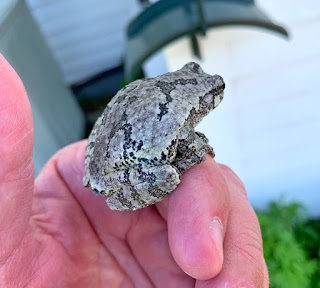click on image for a closer look
This amphibian sports a number of chameleon-like qualities allowing it to change in coloration in seconds from green to gray with darker mottling or a solid color. It tends to be darker when it is cold and dark yet can blend-in easily with a tree’s bark or foliage. Field marks for this frog include a white spot below each eye, white belly and bright yellow-orange skin beneath its thighs.
The gray treefrog is nocturnal – foraging in the evening for insects and other bugs and resting during the day in cover. I found this guy beneath my Weber Smokey Joe. The toe pads are pronounced and produce a sticky substance allowing this critter to cling to various surfaces.
While the breeding season is presently in full swing - this species will sing beyond the breeding season, especially on warm, rainy or humid days. The female selects a mate based upon his call, lays up to 2000 eggs in groups of 10 to 50. The tadpoles hatch in four or five days and will change into froglets in about two months.
The gray treefrog overwinters under leaf litter, logs and rocks and actually freezes. It produces large amounts of glycerol replacing water in vital organs which acts like antifreeze and prevents ice crystals from forming in the cells. The frog’s body freezes and its heartbeat and breathing stop. When the temperature warms up – the frog thaws out and emerges to serenade us with its calling.





No comments:
Post a Comment